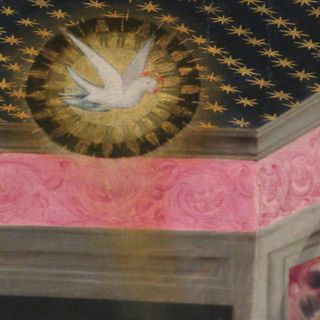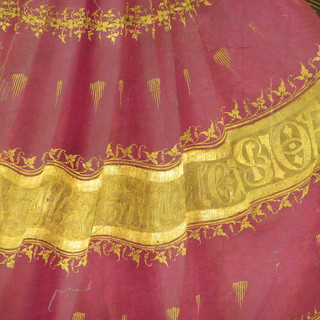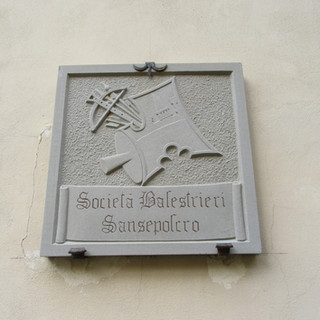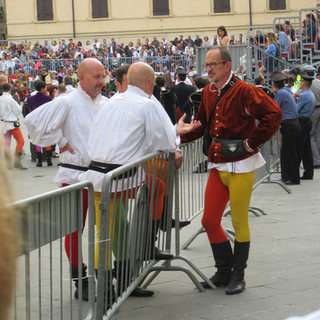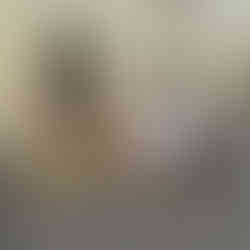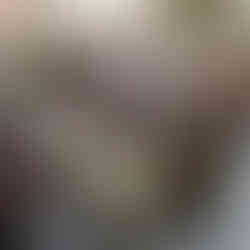Four Tuscan Towns
- Gerriann Brower

- May 18, 2017
- 8 min read
Updated: Jun 18, 2022
Four Tuscan Towns: San Giovanni Valdarno, Sansepolcro, Colle di Val d'Elsa and Monteriggioni.
Don’t like big museums? Overwhelmed by tourists in Florence? Here are four delightful small towns in Tuscany, perfect for those who don’t like mega-museums or a tourist mono-culture and want to find a memorable experience. Guaranteed in each town: good food, good wine, good art. Try the road less traveled and find Tuscany.

San Giovanni Valdarno (red marker) with Sansepolcro to the far right.
San Giovanni Valdarno
Big Tom’s Birthplace and a stunning Fra Angelico
This unassuming Tuscan town near Florence and just off the A1 tollway is tucked next to industrial buildings and sprawling housing. It is primarily known as the birthplace of Tommaso Cassai, otherwise known as Masaccio – Big Tom – the groundbreaking Renaissance painter. His birthplace, Casa Masaccio, is a museum devoted to his life although there isn’t any of his artwork there.
New Towns Museum
Museo delle Terre Nuove (museum of the new towns) housed in the historic Palazzo d’Arnolfo and the adjacent Museo della Basilica (Basilica museum) make this a worthwhile trip. The staff of these museums demonstrated hospitality not found in large urban museums and genuine interest in explaining the exhibits and our ability to get the most out of our visit. Their pride for their town and cultural heritage was sincere. However, I must confess I speak fluent Italian which did positively influence our visit and in the case of the Museo delle Terre Nuove we received a warm invitation to share cake and refreshments with the staff at the conclusion of our visit.

Palazzo d'Arnolfo

Coats of Arms, Palazzo D'Arnolfo
The Terre Nuove is an unusual exhibit. It is devoted to the social and political changes in Medieval Europe; population growth, economic changes and urban planning. The focus is on Tuscany and the growth of San Giovanni Valdarno as a new town of the Florentine Republic. Although the exhibits were in Italian, the multi-media, simulations, models, maps, and videos are beneficial for non-Italian speaking visitors. This new museum is situated in the historic building of Palazzo d’Arnolfo. Arnolfo refers to Arnolfo di Cambio, sculptor and painter. He was the architect of the Palazzo. In the piazza outside children play, old men sit and watch, and visitors can marvel at the many coats of arms on the Palazzo façade. Some of these are terracotta by the della Robbia shop.
Museum of Santa Maria delle Grazie
The Museo della Basilica di Santa Maria delle Grazie (the museum of the church of Santa Maria delle Grazie) houses works by Masaccio’s brother, Lo Scheggia. The technical proficiency between Masaccio’s and his brother is evident. Also in the museum is a stunning Fra Angelico Annunciation from 1432.

Fra Angelico, Annunciation, Museo della Basilica di Santa Maria delle Grazie.
As the pre-eminent painter in Tuscany, Fra Angelico was the preaching painter. Born Guido da Fiesole, he was known as the “angelic friar” hence his name, Fra Angelico. A pious Dominican, he was the “it” painter after Masaccio’s untimely death in 1428/1429. Fra Angelico was prolific, a quick painter, had clients from religious as well as lay organizations, prominent families, and an established studio. His art exerted great influence for decades to come.

Fra Angelico, Annunciation, Museo della Basilica di Santa Maria delle Grazie, detail.
His Annunciation, originally in a Franciscan church, shows subtle influences from Masaccio in the architecture rendered with perspective and soft modeling of the figures. Yet he adheres to traditional Gothic use of gold in the architectural elements, drapery, and halos. This painting confirms that multiple styles were not only acceptable but desired and that art in the early 1400s was not a step-by-step progression of increased use of perspective, modeling, and depth.
The Annunciation depicts the angel Gabriel announcing to Mary that she will be with child via the Holy Spirit who is positioned above Mary’s head. The Garden of Eden is visible through the arches in the left background. Mary humbly folds her arms in an act of surprise.
Fra Angelico, Annunciation, Museo della Basilica di Santa Maria delle Grazie, details.
Fra Angelico’s paintings – particularly panel paintings – exude a luminous quality, a sincere gracefulness and beautiful use of colors. The pink unifies the composition in the clothing, the painted band around the interior space, and the blotches of pink on the floor to signify marble. There is considerable pink in the predella panels (the smaller panels below the main picture). He uses gold to signify the divine, a color that does not dominate in his later paintings. His figures are always restrained in emotion and refined.
Sansepolcro – Men in Tights
Winding up the hills northeast of Arezzo, past tobacco fields, the mundane suburban approach to Sansepolcro doesn’t appear to merit the journey. But the historic center is worth the trip. Especially in mid-September for Il Palio della Balestra, the cross-bow competition.

Participants in Il Palio.
This is an authentic festival taken very seriously by the locals – not to be confused with the so-called Renaissance Fairs in the States. No face paintings, glitter, fairies or cringe worthy costumes here, but plenty of dashing Italian men in multi-colored tights representing their neighborhoods. The men from Sansepolcro and rival town Gubbio compete in shooting crossbows across the piazza into very small targets to roars of the crowd. The competition originated in the 1400s and still goes on today with much pageantry and pride.
In addition, there is a market place selling crafts and the townspeople dress in costume for the occasion. There was much drum pounding, horns blowing, flag throwing and ceremony to accompany the cross-bow competition. This all takes place in the historic center of town and it brings the late Medieval and early Renaissance to life. Everyone is in a festive mood and young and old participate fully in the event.
Scenes from the Palio market

Favorite Son
The star of Sansepolcro is without a doubt the painter Piero della Francesca. The Museo Civico houses two of Piero’s masterpieces, the Misericordia and the Resurrection. The museum is situated in the former Palazzo Comunale (town hall) and Palazzo dei Conservatori. Small and inviting, the museum houses other lesser known Italian artists (Santi di Tito, il Pontormo) as well as being interesting architecturally, serving double duty as a civic museum and art museum. Piero, although most art historians would rate him as a good but not innovative artist, gained quite a following in the nineteenth century which survives today. The towns of Arezzo, Monterchi, and Sansepolcro all advertise the “The Land of Piero” to entice tourists.

Piero della Francesca, Misericordia, Museo Civico, Sansepolcro
Piero lived for many years in Sansepolcro and the Misericordia altarpiece was his first major commission, although it was not completed until four decades later in 1462. When multi-paneled altar pieces went out of style they were sawed apart and sold. Fortunately the 23 panel pieces were recovered and are displayed together.

Piero della Francesca, Misericordia, Museo Civico, Sansepolcro, detail of four women, maiden to crone.
Piero, like Fra Angelico, didn’t emphasize drama, but prefers a dignified solemnity in his subjects. Above all, Piero strives for unity of composition. He strips down extraneous objects or subjects to concentrate on a powerful rendition of the Madonna as intercessor. Under her protective cloak are four men and four women; each from a different life stage. The man with the black hood is from the Misericordia confraternity (lay religious group) providing services to the sick, especially in times of plague. The Madonna of the Misericordia type was well known but Piero simplified the composition. In many other depictions there is a crowd of people under the Madonna’s protective cloak.

Piero della Francesca, Misericordia, Museo Civico, Sansepolcro, detail.
Piero is not a great colorist like Fra Angelico, but uses shape and repeated patterns of figures to convey emotion. He avoids overcrowded scenes and decorative details. Piero was a slow painter and was not the “it” painter of his time, quickly falling out of favor until the nineteenth century when was he was rediscovered by painters who favor geometric patterns, like Cezanne.
Christ in the Town Hall
The Resurrection was painted for the Sansepolcro Town Hall so that legislators would govern under Christ's presence. At the time of my visit the painting was undergoing extensive renovation and restoration. Since Italy has so many great artworks it is common to find buildings with scaffolding or paintings under restoration. Fortunately the museum had partial views of the painting and a large reproduction with computer assisted graphics.

Piero della Francesca, Resurrection, Museo Civico, Sansepolcro. The reproduction is on the left; the fresco in restoration up the stairs.
Piero again includes only the essentials: Christ and the sleeping guards. Two ingenious perspectives are used; one looking up towards Christ from the guard level and the other directly into Christ’s eyes. Legend has it that the guard second from the left is Piero’s self-portrait.

Piero della Francesca, Resurrection, Museo Civico, Sansepolcro. View of the painting in restoration. The white areas are where paint is damaged. Piero's self-portrait is second from the left.
Christ’s posture with one leg on the tomb and the right hand holding the flag signifies a combination of two traditions: the triumphant standing Christ (with barren trees in the background) and the judging Christ, usually in a seated position (with leafed out trees in the background).

Piero della Francesca, Resurrection, Museo Civico, Sansepolcro. View of the painting in restoration.
Historians are able to determine the length of time it takes a painter to complete a fresco by the giornate or “days” evident in the plaster sections. Painters applied fresh plaster only for the section they could complete in one day. About three hours was the amount of time the plaster was paintable. Evidence confirms Piero was a very slow painter as he took a day for each face and a total of 16 giornate for the painting. The Resurection measures about seven by six feet.

Piero della Francesca, Resurrection, Museo Civico, Sansepolcro.
Colle di Val d’Elsa: High and Low
About one hour drive almost directly south of Florence lies Colle di Val d’Elsa. It is a great base to explore Chianti, Siena and other sites. Up on the hill is the old town Colle Alta; down below is the lower town Colle Bassa with modern supermarkets and shops. A tunnel with an elevator connects the two. It’s like two different worlds and the tunnel is like a time machine back to Medieval and Renaissance periods. Literally the town name means Hill of the Valley Elsa and for flatlanders it seems more like a mountain than a hill. About 45 minutes from Siena, the town and surrounding countryside represents a true Tuscan slice of life since it is not overwhelmed by tourists.

Colle di Val D'Elsa with Monteriggioni to the south.
Historically its position meant it was fought over by rivals Siena and Florence. Colle is the birthplace of Arnolfo di Cambio, thirteenth century sculptor and architect. Arnolfo was the architect responsible for the imposing Palazzo Vecchio in Florence as well as the Palazzo d’Arnolfo in San Giovanni Valdarno. He also was the first architect to work on Santa Marie del Fiore, the Duomo of Florence.
The Museo Civico and Diocesano d’Arte Sacra has some 13-17th century local art work. Also of interest is the Romanesque church Santa Maria in Canonica, San Francesco with a Renaissance cloister as well as a few other churches in town. The main attraction in Colle is walking through the old town and exploring the narrow streets.

Colle di Val d'Elsa, Colle Alta
The lower town has market day where you can find everything from clothes, food, and household goods. One memorable day we discovered there was a four hour sciopero generale – a general strike when schools, supermarket, city hall and other unionized worked protested retirement benefits. The strikers picked the time and day – which just happened to be market day. The market was packed. No signs or visible protest taking place, just lots of chatting, visiting, and it seemed more like a party or reunion than a strike. Viva l’Italia!
Monteriggioni - Walled Town
Monteriggioni has well preserved Medieval walls and towers from 1213-19. Walled towns with great views meant great defense against other city-states. It is an intimate, small scale commune tactically located about one hour from Florence and thirty minutes from Siena, which so it was in a key position during all the battles for dominance between the two larger cities.

Monteriggioni
Referenced by Dante in the Divine Comedy, the town is a good place to imagine life in the thirteenth century. Santa Maria Assunta is a Romanesque church facing the piazza and an Arms Museum displays reproduction weapons and battle gear. Visitors can walk atop the Medieval walls and admire the Elsa Valley.
The un-assuming town lies just off the main road, surrounded by farm land. It looks like a little Medieval town popped up suddenly in the middle of farmland.
Sources
Ahl, Diane Cole. Fra Angelico. Phaidon Press, 2008.
Banker, James R. Piero della Francesca: Artist and Man. Oxford University Press, 2014.
Wood, Jeryldene M., ed. The Cambridge Companion to Piero della Francesca. Cambridge University Press, 2002.



